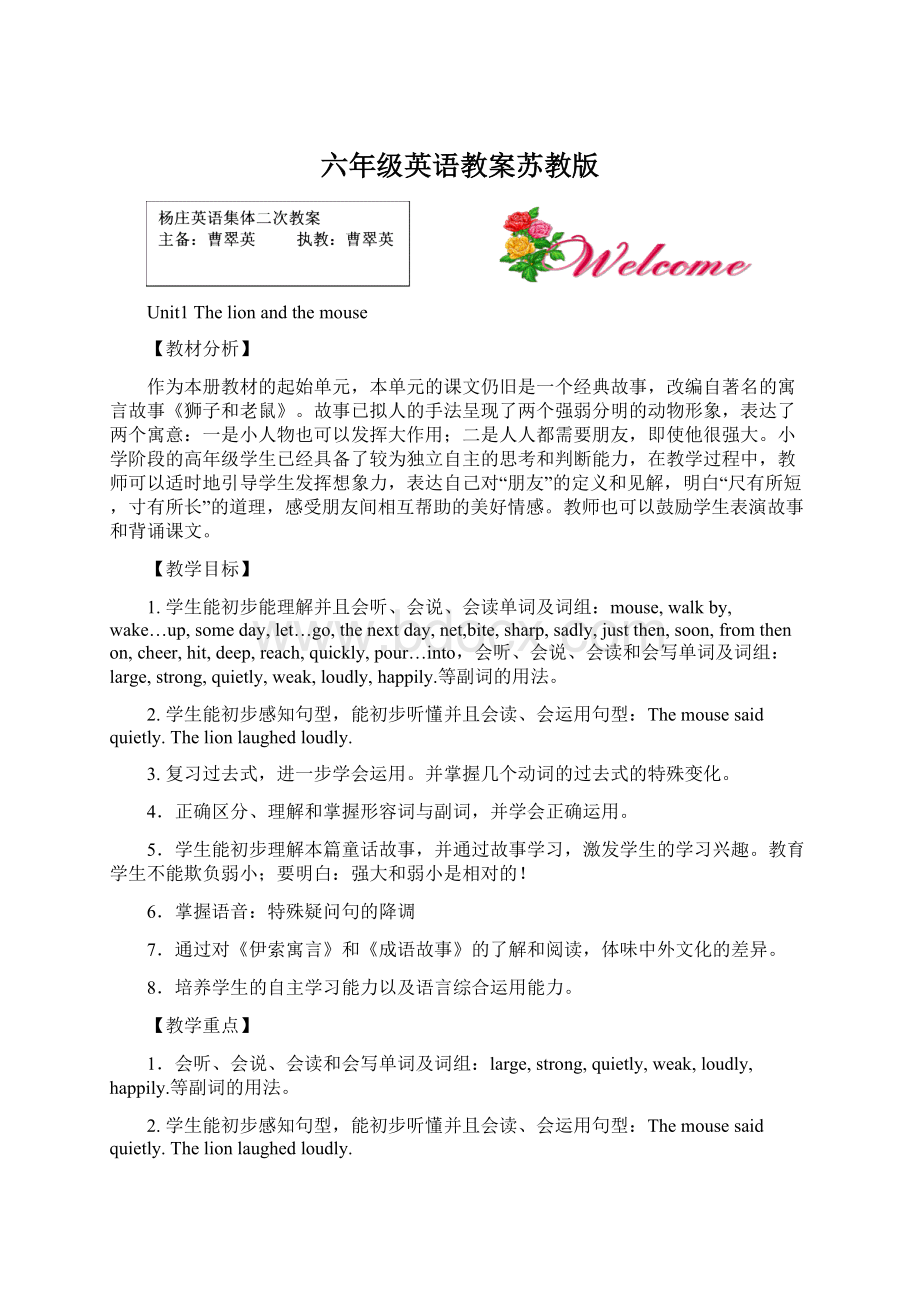六年级英语教案苏教版文档格式.docx
《六年级英语教案苏教版文档格式.docx》由会员分享,可在线阅读,更多相关《六年级英语教案苏教版文档格式.docx(111页珍藏版)》请在冰豆网上搜索。

第二课时:
Grammartime&Funtime
第三课时:
Soundtime,Culturetime&
Cartoontime
第四课时:
Checkouttime&
Tickingtime
第五课时Tickingtime&
Exercise
第六课时复习Unit1所有内容以及完成相关练习
Period1
【教学内容】
1、能听懂、会说、会读词汇mouse,large,strong,walkby,wake…up,someday,quietly,loudly,thenextday,net,bite,sharp,ask,justthen,soon,getout,happily,fromthenon,weak。
2、能听懂、会说、会读日常句型:
Themousesaidquietly.Thelionlaughedloudly.Thelionaskedsadly.Thelionsaidhappily.
3、复习过去式,进一步学会运用。
4、能在理解的基本上,熟练朗读并试着复述故事。
5、通过阅读故事,教育学生不能欺负弱小;
能在理解的基本上,熟练朗读并试着复述故事。
【课前准备】
句子板书,单词卡片,课文图片,PPT
【教学过程】
Step1.Organization:
1.Greetings.
2.Freetalk:
Whatdayisittoday?
Howistheweathertoday?
Doyoulike…?
Step2.Presentationandpractice:
1.T:
Doyoulikeanimals?
Ss:
Yes,Ido.
T:
Whatanimalsdoyouknow?
S:
tiger,cat,dog,bear,…
2.T:
Todaywe’regoingtolearnastoryaboutanimals.Whatanimals?
Canyouguess?
(检查学生预习)
Thelionandthemouse.
3.Let’stalk:
1).T:
Howaboutthelion?
通过学生交流,学习:
large,strong,sharp等单词。
2).T:
Howaboutthemouse?
让学生通过对比,交流。
引出:
small,weak等单词。
3).集体说一说,lion和mouse的异同。
e.g.Thelionislarge.Butthemouseissmall.
Thelionisstrong.Butthemouseisweak.
Thelion’sandthemouse’steetharesharp.
4.Readthestory.
Whathappenedtothelionandthemouse?
Wouldyouliketoknow?
Readbyyourselves.
2).Ssreadthestory.
5.Trytotellthestory.
Pic1.
Wherewasthelion?
Itwasintheforest.
Hewaslargeandstrong.
Whatotheranimalscanyousee?
Icansee…
Dotheylikethelion?
No,becausethelionwantedtoeatthem.
2).Let’strytosay.
T&
Ss:
Therewasalionintheforest.…
Pic2.
CanyousaysomethingaboutPic.2?
S1:
Thelioncaughtthemouse.
S2:
Thelionlaughedloudly.
S3:
Themousewassmall.
…
Whydidthelioncatchthemouse?
Becausethemousewalkedbyandwokethelionup.
学习:
walkbywokeupwoke(wake的过去式)
3).ReadthestoryaboutPicture2together.
Pic3.
Whathappenedthenextday?
Twomencaughtthelionwithalargenet.
Howwasthelionnow?
Itwassad.
Why?
Doyouknow?
Becausethelioncouldn’tgetout.
Becausethelionwastired.
Thelionwasinthenet.Whatdiditdo?
通过回答:
学习bit…withbit(bite的过去式)强调两个单词的不同读音。
2).Readthestoryaboutthispart.
Pic4.
Thelionwassad.Butwhocame?
Themouse.
Couldthemousehelpthelion?
Yes,hecould.
Whatdidthemousedo?
Themousemadeabigholeinthenetwithhissharpteeth.
Whatdidthelionsay?
2).Readthispart.
Pic5.
Whatdidthemouseandthelionbecome?
Theybecamefriends.
6.情感教育:
Don’tlookdownupontheweak!
别小看弱者!
Step3.Consolidation:
1.Let’sread!
1).Readthewholestoryinpairs.
2).Readtogether.
2.Readandorder.
Youknowtheirstory,Ithink.Pleasereadthesesentencesandtrytoorderthem.
2).学生读句子,并试着排序。
3).交流,试着说一说。
3.Askandanwer:
1).四人小组,对故事进行提问,先问书上的句子,再进行一些拓展。
2).集体问答。
4.Retellthewholestory.
1).根据板书和问题等,试着集体复述本课故事。
2).两人说一说。
要求:
根据图片和板书,整合句子复述故事。
5.Recommend:
Aesop’sFables.
Step4Homework
1.朗读故事,并试着把故事讲给同学或家长听一听。
2.阅读英语版《伊索语言》小故事,并尝试讲一个。
板书设计:
Unit1Thelionandthemouse
largestronglaughloudlyasksadlysayhappily
老鼠图
sharpsmallweaksayquietly
Period2
Grammartime&
Funtime
1、正确区分、理解和掌握形容词与副词,并学会正确运用。
2、进一步复习过去式,并掌握几个动词的过去式的特殊变化。
3、在理解与熟练朗读的基础上,尝试讲故事和表演故事。
4、通过讲故事,体会故事阅读的乐趣;
同时教育学生养成乐于助人的好习惯。
2、在理解与熟练朗读的基础上,尝试讲、演故事。
正确区分、理解和掌握形容词与副词,并学会正确运用。
单词卡片,PPT、图片、头饰等
Whatdayisittoday?
What’stheweatherliketoday?
Whatwasitlikeyesterday?
Doyouoftenspeakloudly?
Doyouoftenlaughloudly?
Doyouoftensinghappily?
Step2.Revision:
Whatanimalalwaysspeakedloudly,thelionorthemouse?
Thelion.
Whatanimaloftenlaughedloudly,thelionandthemouse?
Butoneday,didthelionsayandlaughloudly?
No.Hesaidsadly.
DoyouknowthestoryaboutThelionandthemouse?
Trytosayoneortwosentences.
学生试着回忆故事,讲一至两句与故事相关的句子。
3.齐读故事。
4.看着插图,试说故事的梗概。
Step3.Funtime:
Sayandact
1.Let’ssay!
1).呈现P10的三幅插图,引导学生逐图说一说。
2).个别交流。
3).集体说一遍。
引导学生关注动物们的神情变化,加上不同的语气读一读。
4).同桌试着说一说。
2.Let’sact!
1).戴上头饰,师生试着说一篇。
2).学生上台表演。
Step4.Grammartime
1.T:
Youdidagoodjob.Look,herearesomeimportantsentences.
板书呈现故事中的几个重要句子:
(P9方框中内容)
Canyouread?
学生读一读句子。
3.T:
Whatcanyoufind?
1).学生自主探究,发现句子的特点。
2).学生交流:
a.句子中结尾的单词,都是“…ly”。
b.句中都含有“动+副”结构。
3).小结:
副词与动词连用;
副词的变化规则:
一般情况下,只要在形容词后面加“ly”;
辅加y结尾,要去y,改成i,再加ly,如happy—happily。
4.Let’sread!
1).快速读副词:
sadly,loudly,quietly,happily
2).读“动+副”的词汇:
如:
asksadly,laughloudly
5.Let’ssay!
1).读副词,并说出其形容词。
sadly–sadloudly–loudquietly–quiethappily–happy
2).Whatelse?
让学生试试说一说,其他加“ly”变成副词的单词。
beautifully,carefully,quickly.
6.Let’stry!
根据句意,完成填空。
1).Todaysheis.Sheiscryingnow.(sad)
2).Themanis.Heoftensitsthere.(quiet)
3).He’saboy.Helaughs.(happy)
a.学生读一读,自己试着填一填。
b.交流。
c.小结形容词与副词的用法。
7.T:
Youknowthenextday,thelionwasinthenet.Whatdidhedo?
Hebitthenetwithhissharpteeth.
Right.Hebitthenet.
朗读:
bit
提问学生它的原形:
bite
让学生朗读:
bite–bit强调两个“i”的不同发音,比较后,朗读,强化记忆。
8.呈现P9过去式和原形。
学生同桌尝试朗读,记忆。
Step5.Consolidation:
1.T:
Youknowthestoryabout“Thelionandthemouse”well.Whatwillyousaytothem?
Youcanuse“Please…”、“Don’t…”
2.学生交流。
3.情感教育:
Animalsshoudbefriends.Theyshouldhelpeachother.Howaboutyou?
Step6.Homework
1、朗读Storytime的小故事,并在教室内进行循环讲故事比赛。
2、朗读Grammartime内容,背诵、记忆,并尝试运用。
Unit1Thelionandthemouse
Thelionaskedsadly.(副词)
laughedloudly.
Themousesaidquietly.
happily.
Period3
【教学目标】:
1、能听懂、会说、会读词汇cheer,hit,ground,reach,deep,hole,begoodat,pour…into。
2、能听懂、会说、并发音准确:
特殊疑问句和陈述句的降调。
3、通过对《伊索寓言》和《成语故事》的了解和阅读,体味中外文化的差异。
4、通过阅读Cartoontime故事,提高学生阅读欣赏的能力。
1、能读懂Cartoontime,并在理解的基础上进行简单的表演。
2、掌握语音:
能读懂Cartoontime,并在理解的基础上进行简单的表演。
单词卡片,课文图片
Step1.Organization:
DoyouknowanyotherstoriesaboutAesop’sFables?
Canyoushowus?
朗读Aesop’sFables
读音比较:
fabletable让学生进行尝试记忆。
Step2.Revision:
1.TellthestoryaboutThelionandthemouse.
1).Asksomestudents.
叫几名学生进行故事接力赛。
2).Telltogether.
2.Actthestory.
Step3.Culturetime
1.KnowsomethingaboutAesop’sFables.
2.KnowsomethingabouttheChineseidiombook.
1).学习:
idiom
2).LetSssaysomenamesofidiom.
3).Doyouknowthesestoriesverymuch?
4).AskstudentstoreadsomeontheInternetafterclass.
3.小结:
这两本书的故事,都蕴含着深刻的寓意,它们都教给我们一些做人的道理。
Step4.Soundtime
Soboysandgirls,whatareyougoingtodoafterclass?
We’regoingtoreadsomestories.
Oh,Isee.Butlookatthisboy,whatishegoingtodo?
2.(呈现Soundtime插图)
He’sgoingtoasweetshop.
2).朗读:
sweetshop
3).提问:
Whatothershopsdoyouknow?
归纳:
juiceshop,bookshop等。
4).T:
Whatdoestheboywanttobuy?
Alollipop.
lollipop
提问:
Doyoulikelollipops?
Lollipopsarenice.Butdon’teattoomuch!
5).T:
Whoarethemanandwoman?
Maybetheyarehisfatherandmother.
Yes,theyaregoingtobuythelollipopfortheboy.
3.Trytoread.
4.Whatdoyoufind?
让学生说一说:
这些问句后面,只要用降调来读。
小结:
一般情况下,特殊疑问句和陈述句,都用降调。
5.Readthisparttogether.
6.朗读比赛。
Step5.Cartoontime
Sohowistheboy?
Heishappy.
Yes,heishappytoeatalollipop.
Howaboutourfriends,BobbyandSam?
(呈现Bobby和Sam)
Theyarehappy,too.
Whataretheydoingnow?
S:
Theyareplayingtabletennis.
Cantheyplaywell?
Yes,theycan.
Right.Theyaregoodattabletennis.
begoodat
Theyaregoodattabletennis.
Whatareyougoodat?
在学生回答时,自然渗透与归纳:
begoodat+名词/动词ing
3.Readthestorybyselves.
4.T:
Doyouliketheirstory?
Whichpartwouldyouliketoreadforus?